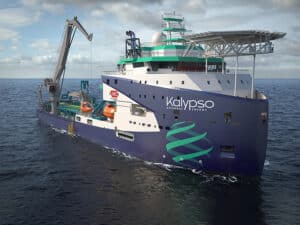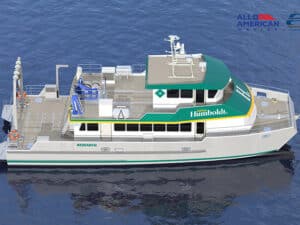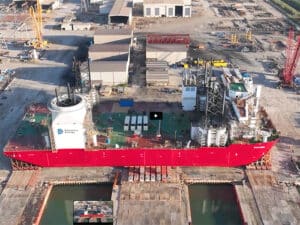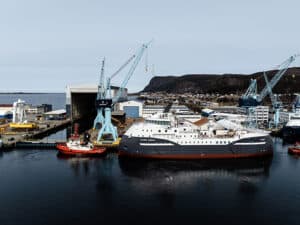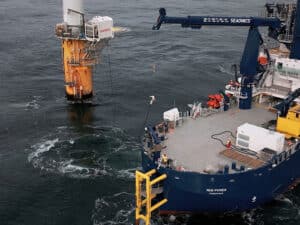
Floating wind continues to gain momentum in the U.S.
Written by Heather Ervin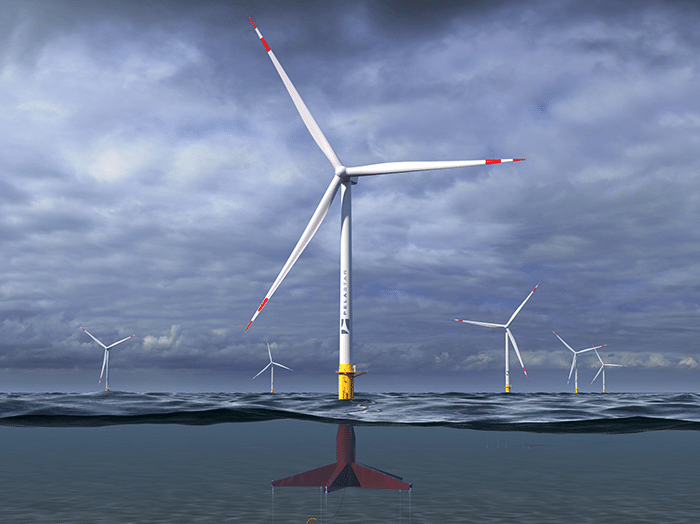
There’s an increasing momentum in floating wind from a combination of private investment and public policies. (Credit: Glosten)
If you asked Seattle-based naval architecture and marine engineering company Glosten where its sees floating wind progress in the U.S., it’d have a lot to say. This especially holds true for the increasing momentum it sees from a combination of private investment and public policies.
Glosten’s PelaStar business segment, which focuses on offshore floating wind, was first conceived by its engineers in 2006 when the need to reduce capital costs of offshore wind and access sites with superior wind resources was recognized.
Kris Volpenhein, PelaStar’s commercialization lead for Glosten, says that while we are experiencing the start of an exciting floating wind boom in the U.S., there are still significant gaps and investments needed to bring the ambitious deployment and cost reduction targets and production capacity to reality.
Last December, we saw the first commercial scale floating wind auction round in California that generated significant high bids from some of the largest offshore wind developers in the world. “Lease areas that include at least some floating-specific sites have been identified and will be progressing towards lease auctions in 2023 and 2024 in Maine, Oregon, the Gulf of Mexico, and the Central Atlantic,” adds Volpenhein.
While utility scale floating wind farms are still several years from deployment, the Department of Energy (DOE) has put a series of programs in place that incentivize development in key areas, such as transmission and port infrastructure, investment and production tax credits, and environmental and stakeholder engagement.
“These are mostly encompassed in the Floating Offshore Wind Shot program,” says Volpenhein. “With PelaStar, Glosten is primarily engaged via the FLOWIN competition and advising the West Coast Ports Strategy Study.”
On March 29, the DOE named Glosten one of nine Phase One winners of the FLoating Offshore Wind ReadINess (FLOWIN) Prize for its PelaStar tension leg platform (TLP). Each Phase One winner is to receive $100,000 cash and $75,000 in vouchers for technical support provided by DOE national laboratories. In total, the FLOWIN Prize has a cash pool of $5.85 million, plus up to $1.175 million in technical support.
It should be noted that Glosten’s primary focus in the floating wind market is the scale up and commercialization of its TLP as the most practical and cost-effective floating platform for most deepwater sites, globally, says Volpenhein.
“Beyond PelaStar, Glosten remains engaged with the offshore wind market, particularly on the U.S. East Coast,” he says. “We continue to look for opportunities in support vessel design, as well as assisting developers and logistics companies with marine logistics and planning services.”
And it seems as though those opportunities are ample.
“Depending on the specific role or assets, these opportunities could look like obvious needs, such as newbuild OSVs (offshore support vessels) or feeder barges to less clear needs for support logisitics and marine construction opportunities when investments and locations start to materialize over the coming years,” adds Volpenhein.
Maine project moves along
One such East Coast opportunity is a floating offshore wind research project off the coast of Maine that recently cleared another regulatory hurdle. The Bureau of Ocean Energy Management (BOEM) announced a Determination of No Competitive Interest for the proposed research lease area. This decision follows BOEM’s Request for Competitive Interest (RFCI) in the Gulf of Maine, which was issued last August.
BOEM’s determination means it will move forward with the State of Maine’s research application, which could be used to inform any future commercial offshore wind development in the Gulf of Maine, as well as the deployment of floating offshore wind technology nationwide.
Back in July 2021, Maine Gov. Janet Mills signed into law legislation prohibiting new offshore wind projects in state waters—where up to 75% of Maine’s commercial lobster harvesting occurs—saying Maine’s priority was to locate offshore wind projects in federal waters in the Gulf of Maine. Those waters are at a depth that would require the use of floaters and Gov. Mills had previously signed separate legislation to advance the state’s creation of America’s first research area for floating offshore wind in federal waters in the Gulf of Maine.
To implement the floating wind research project, the University of Maine is collaborating with New England Aqua Ventus, LLC (NEAV), a joint venture between Diamond Offshore Wind, a subsidiary of the Mitsubishi Corporation, and RWE Renewables.
As the developer, NEAV will own and manage all aspects of permitting, construction and assembly, deployment, and ongoing operations for the project. The university’s Advanced Structures and Composites Center will continue with design and engineering, research and development and post-construction monitoring.
BOEM says the next steps for processing the research application include publishing a Determination of No Competitive Interest in the Federal Register and initiating an environmental review of potential impacts from offshore wind leasing activities associated with the research lease.
Floating Offshore Wind Shot
The White House back in September announced a new multi-agency floating offshore wind initiative called the Floating Offshore Wind Shot. It will see the administration advance lease areas in deep waters in order to deploy 15 GW of floating offshore wind capacity by 2035. This builds on President Biden’s goal of deploying 30 gigawatts (GW) of offshore wind by 2030, which will be largely met using fixed-bottom offshore wind technology. Additionally, the Floating Offshore Wind Shot includes a goal of reducing the cost of floating offshore wind energy by more than 70%, to $45 per megawatt-hour by 2035.
A White House fact sheet says that achieving this cost target will require focused research, development, and demonstration to catalyze continued cost reductions, with a focus on manufacturing, engineering, and continued increases of offshore wind turbine capacity. Agencies will also continue collaborating to develop the robust domestic supply chain and transmission infrastructure needed to accelerate floating as well as fixed-bottom offshore wind.
The fact sheet notes that conventional offshore wind turbines can be secured directly to the sea floor in shallow waters near the East Coast and the Gulf of Mexico. However, deep-water areas that require floating platforms are home to two-thirds of America’s offshore wind energy potential, including along the West Coast and in the Gulf of Maine.
The administration aims to capture this potential and says its actions will “position the U.S. to lead the world on floating offshore wind technology.”
Globally, only 0.1 GW of floating offshore wind has been deployed to date, compared with over 50 GW of fixed-bottom offshore wind, and the Administration sees this as an opportunity for the U.S. to become a frontrunner on floating offshore wind technologies.
Meantime, floating wind farms are already being installed in other areas, including the WindFloat Atlantic project in Portugal using ABS-classed, semi-submersible units designed by Emeryville, Calif.-headquartered Principle Power and housing MHI Vestas turbines.
Another company to keep an eye out for is France-based BW Ideol AS. The company recently entered into a €40 million ($43.1 million) agreement with ADEME Investissement to fund BW Ideol’s project development activities. BW Ideol has two full-scale offshore floating wind turbines in operation in France and Japan and is supported by BW Offshore’s extensive experience from developing and operating offshore energy production systems.
Any new floating wind technologies will thus face the challenge of demonstrating that they are a better choice than some that have already established a track record.

